nv03.gif) image by
Martin Grieve, 24 Aug 2005
image by
Martin Grieve, 24 Aug 2005
Last modified: 2013-04-05 by peter hans van den muijzenberg
Keywords: south africa | navy |
Links: FOTW homepage |
search |
disclaimer and copyright |
write us |
mirrors
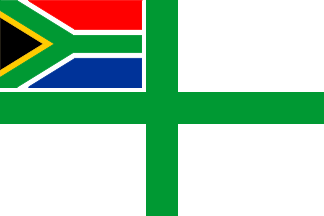 image by Martin Grieve, 24 Aug 2005
image by Martin Grieve, 24 Aug 2005
The new South African Naval Ensign is the same as that used previously except the
new SA national flag is in the canton and the badge of the Navy no longer
appears in the fly. It was the third version of the SA Naval Ensign which
comprised the former SA flag in the canton with a green Scandinavian cross
on a white background in the proportion 1:2 in use between 1952-1959. Thereafter
between 1959 and 1981 a white fimbriation was added around the national
flag to separate it from the cross. In 1981 the Naval emblem was added
to the lower fly and the proportions changed to 2:3 (as in the case of
the National flag). This version was used until 1994 when the new flag
was added and once again the naval emblem was dropped from the fly - the
proportions remain 2:3.
Bruce Berry, 06 March 1996
With the adoption of the new South African national flag on 27 April 1994, the use of the previous naval ensign containing the old national
flag was no longer appropriate. Hence a new South African naval ensign was approved by the Chief of the South
African National Defence Force on 29 September 1994. This design differs from its immediate predecessor in that new national flag appears
in the canton and the navy emblem no longer appears in the lower fly. The new ensign is thus:
"a rectangular white flag, in the proportions of two to three; with thereon a dark green cross; and having in the upper hoist canton the
national flag of the Republic of South Africa, with a white fimbriation".
It also needs to be noted that the shade of green has been standardised so that the green cross and the green "pall" of the national flag are
now both the same shade - PMS 349 - whereas previously the cross was the
darker "tartan green".
nv03.gif) image by
Martin Grieve, 24 Aug 2005
image by
Martin Grieve, 24 Aug 2005
As with the other arms of the Defence Force, the navy has also recently adopted a new emblem to replace that based on the Cape Castle outline. As the emblem is no longer on the ensign, the pattern of the ensign is no affected by the change in emblem.
The new naval ensign was carried for the first time at a Defence Force
parade held in Pietersburg on 11 November 1994 and hoisted on the Ensign Staff of naval vessels at noon on the same day. Between 27 April and
noon on 11 November 1994, the South African National Flag served as a temporary ensign.
Bruce Berry, 23 Apr, 2004
A new emblem appears on the SA Navy
website. When was this
"anchor" emblem introduced? Is the emblem a part of any flag?
Kristian Söderberg, 28 Jan 2006
The emblem was introduced in in 2002/3 along with new emblems for all the other
arms of the South African National Defence Force.
The new emblems appear on all the flags of the various Arms, i.e. Army, Air
Force, Military Health Service, but not on the Naval Ensign. The introduction of
the old emblem on the Naval Ensign in 1981 caused much unhappiness in the Navy,
so that when the new national flag was introduced in 1994 and replaced the old
national flag on the flags of all the Arms of the Service, the Naval Board
decided to keep the Naval ensign clean, i.e. not to put the emblem back in the
lower fly canton as was the case with the 1981 ensign. This decision stood when
the new emblems were introduced in 2003. The Naval Ensign is therefore the only
one of the SANDF's ensigns which does not carry an emblem. The new Navy emblem
is used mainly as a letterhead and for similar purposes.
Andre Burgers, 28 Jan 2006
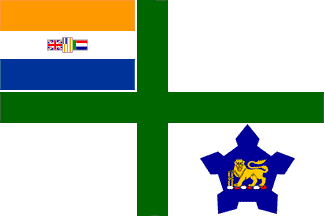 image by Martin Grieve, 23 Apr 2004
image by Martin Grieve, 23 Apr 2004
On 05 March 1981, a new ensign was adopted. This flag changed the proportions of the naval ensign to 2:3. The green cross on white with a fimbriated national flag in the canton was retained; however, the naval badge, the crest of the South African Coat of Arms on a blue ground plan of the Castle of Good Hope, was placed in the lower fly quarter. This flag was flown until 1994.
From 27 April 1994 until 11 November 1994, the South African Navy used
the national flag as the naval ensign. The Republic of South Africa changed
its naval ensign on 29 September 1994. The ensign removed the naval badge
and replaced the old national flag with the current national flag. It was
officially taken into use on 11 November 1994.
There is a South African Naval Colour that consists of the naval ensign
charged with the crest from the coat of arms in the lower quarter."
Sources: SAVA Journal 2/93, "Flags of the Union Defence Forces and
of the South African Defence Force, 1912-1993
[hhs93] ;"
SAVA Newsletter, 11/94;
SAVA Newsletter, 17/96."
Paige Herring, 16 Mar 1998
On 05 March 1981, the Chief of the South African Defence Force approved a
new design for the South African naval ensign, namely:
"a rectangular white flag, in the proportions of two to three; with thereon a dark green cross; and having in the upper hoist canton the
national flag of the Republic of South Africa, with a white fimbriation; and in the lower fly the emblem of the South African navy, to wit:
On a dark blue ground plan of the Castle of Good Hope of the same shade as the blue stripe in the National Flag, a gold lion passant guardant
standing upon a wreath of six links, alternately white and red; and resting the dexter forepaw on four vertical staves, alternatively gold
and dark blue and tied together with a gold ribbon".
nv81.gif) image by Martin Grieve, 23 Apr 2004
image by Martin Grieve, 23 Apr 2004
This ensign was hoisted with appropriate honours as "Colours" on 31 May 1981 and was also carried at a parade held in Durban on the same day and
continued in use until the change in the national flag on 27 April 1994.
Bruce Berry, 23 Apr, 2004
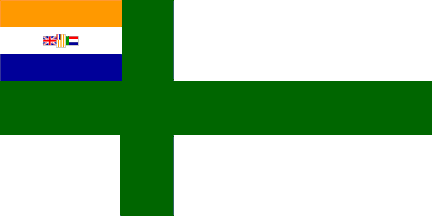 image by Martin Grieve, 26 Apr 2004
image by Martin Grieve, 26 Apr 2004
The third naval ensign reverted back to the British tradition. This
version, adopted 14 November 1952, was 'a dark green cross on a white background
with the Union National Flag in the upper canton next to the hoist.' Because
the design specified that the national flag should be of 2:3 proportion,
the flag (1:2 proportion) had a distinctive Scandinavian cross look. The
third South African naval ensign flew until 1959, when a white fimbriation was
added to separate the national flag from the green cross.
Paige Herring, 16 Mar 1998
On 14 November 1952 notice was given under Government Notice No. 2633 in
the Government Gazette that with effect from 25 March 1952, the South African navy had adopted as its ensign:
"a dark green cross on a white background with the Union of National Flag in the upper canton next to the hoist".
This notice cancelled Government Notice No. 1550 of 26 July 1946, in terms of which the first South African naval ensign had been adopted.
The third design for the South African naval ensign marked a return to
the traditional of the British white ensign with overall proportions of one to two. The width of the dark green cross was one-quarter of the
width of the flag and the horizontal arm lay along the centre of the flag. The vertical arm of the cross was placed such that the canton next
to the hoist had the proportion of two to three (for the national flag). In its original form, this design of the naval ensign had the national
flag placed directly against the vertical and horizontal arms of the
dark green cross. However in 1959, in terms of South African Defence Force Order No. 63,
it was stated that the national flag should be separated from the dark green cross by a narrow white stripe (fimbriation)
as shown below.
The choice of dark green for the cross in 1952 has influenced all subsequent naval ensigns used in South Africa. HH Smith (1993) reports that green may have been chosen rather than the red as found on the British white ensign and other naval flags since green was the vertical stripe at the hoist of the Zuid-Afrikaansche Republiek flag.
There was a further proposed amendment to this design in 1967 to add to the lower fly the crest from the South African Coat of Arms, namely:
"On a wreath of colours (white and red), a lion passant guardant Gules, supporting with the dexter forepaw four staves erect, alternatively
Argent and Azure and banded Or".
nv52.gif) image by Martin
Grieve, 28 Apr 2004
image by Martin
Grieve, 28 Apr 2004
Although the South African State Herald was furnished with an approved art card for this amended design, this ensign was never taken into use. Instead, the design formed the basis of the Naval Colour which was designed in August 1968 and presented to the Navy by Mr PW Botha, then Minister of Defence on 12 April 1969.
The naval ensign, with fimbriation, was used until a new ensign was adopted on 31 May 1981.
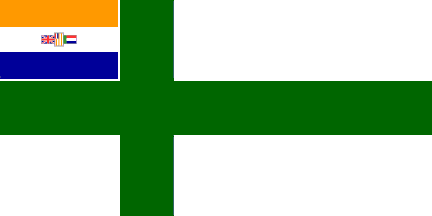 image by
Martin Grieve, 28 Apr 2004
image by
Martin Grieve, 28 Apr 2004
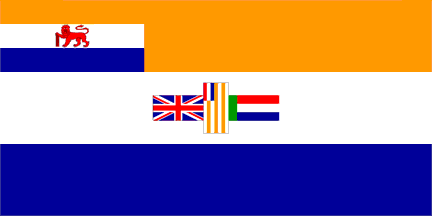 image by
Martin Grieve, 28 Apr 2004
image by
Martin Grieve, 28 Apr 2004
A new design for the South African naval ensign was recommended by Commodore FJ Dean OBE, then the Director-General of Naval Forces on 15
May 1951, namely: "the national flag of the Union of South Africa with an upper hoist canton consisting of three equally wide horizontal
stripes from top to bottom or orange, white and blue. The white stripe of the canton charged with a lion passant guardant Gules, supporting
with the dexter paw four staves erect, alternatively Argent and Azure and banded Or, from the crest of the Coat of Arms of the Union of South
Africa" (see image below).
nv51.gif) image by Martin Grieve, 28 Apr 2004
image by Martin Grieve, 28 Apr 2004
This ensign was approved on 31 May 1951 but HH Smith (1993) reports that it appears not to have found favour in naval circles and as such it was
never flown. This design was also criticised by Dr C Pama - a leading
figure in heraldry and vexillology in South Africa - who suggested that the canton should be omitted and the red lion replace the three small
flags in the centre of the South African flag instead.
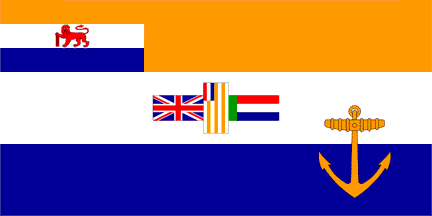 image by
Martin Grieve, 28 Apr 2004
image by
Martin Grieve, 28 Apr 2004
At the same time as this second design of the South African naval ensign had been proposed, a personal flag to be flown at sea by the Minister
of Defence was announced. This flag was of the same design as the naval
ensign but with a fouled anchor in the fly. According to HH Smith, printed references refer to the anchor
as being orange, but he received a letter from the Chief of the Navy referring to a black anchor. Although the Chief of the Navy stated that this flag was never used, it is referred to in an article by Capt. MF
Stern on the flags of South Africa published in the spring 1963 issue of The Flag Bulletin that the Minister of Defence did indeed fly this
ensign in late 1951.
Bruce Berry, 28 Apr 2004
 image by Martin
Grieve, 28 Apr 2004
image by Martin
Grieve, 28 Apr 2004
Following World War II, the South African military discarded the British
White Ensign and began to use a solid white ensign with the South African
flag in the canton. Adopted in 1946, the flag was in 1:2 proportion. As
a result, the national flag, as well as the flags in the center, had to
have a 1:2 proportion (Union Nationality and Flags Act of 1927). This ensign
was changed due to the fact that it was difficult to identify.
Paige Herring, 16 Mar 1998
Prior to 01 September 1946, ships of the South African navy flew the British white ensign and the South
African national flag as a jack. The first specifically South African naval ensign was "a plain white flag
with the national Flag in the upper dexter canton". No proportions were gazetted but the ensign followed the
British tradition of being one to two, giving the South African flag in the canton incorrect proportions. It was soon apparent that the new
ensign was not a good flag from a practical point of view. In particular it was difficult to identify at sea in conditions of bad visibility and
it was not popular with naval personnel who referred to it as the "witdoek" (literally 'white cloth'). As a result there was a
recommendation to change the design in 1951.
(Source: SAVA Journal 2/93: Flags of the Union Defence Forces and of the South African Defence Force, 1912-1993 by Prof. HH Smith)
[hhs93].
Bruce Berry, 28 Apr 2004
From the sources indicted below it would seem that we have the wrong year for
the adoption of the South African Naval Force Ensign.
11th March 1947. South African Department of External Affairs informed the
British Admiralty that South African Naval Force ships wear the South African
White Ensign.
No date of introduction given.
South Africa Government Gazette 26th July 1947. No.1550. It is hereby notified
for general information that the Union Government has decided that with effect
1st September 1947 the South African Naval Force will adopt as their ensign a
plain white flag with the National Flag in the upper dexter canton. [National
Archives (PRO) ADM 1/19753].
David Prothero, 18 Mar 2005
Here follows an extract from 'The South African Flag Book' to be
published soon. The information comes from SAVA Journal SJ: 2/93 and the
contents entitled:
'Flags of the Union Defence Forces and of the South African Defence Force
1912-1993' by the late Professor Hugh H. Smith. He did his research directly at
the South African National Defence Force and National Archives.
"The first South African Naval Ensign (1946 - 1951) - On 17 September
1945, the then Minister of Education and Finance, the Hon. J.H. Hofmeyr,
recommended to the Minister of Defence that: The British white ensign with the
shield of the Union of South Africa's coat of arms in the lower left hand side
should be used as the ensign of the
South African Naval Services.
It is not possible to establish if the 'lower left hand side' was intended to
mean the heraldic left - the lower side of the fly - or if it was intended to
mean the left hand side from the point of view of a person looking at the flag,
i.e. the lower hoist.
That no action was taken to implement this recommendation is clear from the fact
that, at a staff conference held on 8 November 1945, it was decided that the
then Chief of the General Staff - General Sir Pierre van Ryneveld - should
recommend a new naval ensign to the Prime Minister - Field Marshal Jan Smuts.
The new ensign was to be:
a white flag with the national flag of the Union of South Africa in the upper
dexter canton.
At a staff conference held on 6 December 1945 it was announced that the above
recommendation had been accepted; and on 26 July 1946 Government Notice No 1550,
published in Government Gazette 3684 notifying 'for public information'
that:
"the Union Government have decided that, with effect from 1st September 1946,
the South African Naval Forces will adopt as their ensign a plain white flag
with the National Flag in the upper dexter canton."
No proportions were specified in the notice in the Government Gazette,
but in fact as shown in Figure 6.20 of SJ: 2/93, the ensign had the proportions
of one to two; and the National flag of the Union filled the whole of the upper
hoist canton. This followed the proportions of the White Ensign. It meant,
however, that the three flaglets in the centre of the national flag also had the
proportions of one to two, instead of two to three as specified in the
Nationality and Flag Act of 1927. The ensign was hoisted for the first time on 01
September 1946.
In the meantime, the position of the South African Naval Services (SANS) in the
Union Defence Forces (UDF) was regularised. Up to this time the SANS was an
Active Citizen Force unit. It was now added to the UDF as a Permanent Force Arm
of the Service and in 1951 its name was changed to the South African Navy (SAN).
The officers were offered permanent commissions in the UDF and a sufficiently
large number accepted to allow this young Navy to get off to a good start."
It is possible that the SA Dept of External Affairs might have delayed informing
the British Admiralty for some bureaucratic reason until 11 March 1947, but the
dates of the SA Government Gazette and the year of implementation is
without doubt 1946 and not 1947. Also note that the official name of the SANS
was in the plural, i.e. South African Naval Services as was the UDF, i.e. Union
Defence Forces. One wonders how the mistake
about the dates got into the Admiralty archives?
Andries Burgers, 18 Mar 2005
The mistake was not the Admiralty's, it was David Prothero's! I
copied the year of the External Affairs' letter on to the date of the Gazette
when typing up my notes. "Force" instead of "Forces" was also probably my
mistake. I had written only initials. My apologies if I have confused anyone.
The letter from External Affairs was probably in answer to an Admiralty request
for confirmation of the change. They knew it had happened, as they had a copy of
a dispatch on the subject written by the High Commissioner and sent to the
Dominions Office on 14 August 1946.
David Prothero, 19 Mar 2005
The following date is correct. In an off-list message Andries Burgers enquired;
"I have been unable to determine the exact date for the taking into use of the
Unievlag (Union Flag) as the jack".
It was 31st May 1928.
On 11th May 1928, N.H.Rankin, Officer Commanding South African Naval Service to
Admiralty was "Informed by Defence Headquarters that on and after 31st May 1928
Union of South Africa will fly the South African National Flag in place of the
Blue Ensign."
On 14th June 1928 their Lordships approved the new jack (NL 1898/28).
David Prothero, 19 Mar 2005
Thanks for the information about the 31st May. Cdr Rankin's signal implies that
the SANS had worn the Blue Ensign (presumably the SA Blue Ensign?) before 31 May
1928 as the jack. Would this not have been rather unusual in British practice?
Andries Burgers, 19 Mar 2005
I think it was the usual practice for ships of the Dominion Navies - Australian,
Canadian, Indian etc., to fly the defaced Blue Ensign as their jack, and to the
best of my knowledge all (but South Africa) continued to do so whilst they flew
the UK White Ensign.
Christopher Southworth, 19 Mar 2005
I would not necessarily conclude from OC SANS's signal that SANS vessels used a
defaced Blue Ensign as a jack. I am inclined to think that he passed on the
information in the form that it was sent to him. Would Defence HQ have known
what went on in the real world? A meeting in London in September 1928 thought
that SANS vessels had used the British Union Jack.
The business of Dominion jacks is quite complicated.
David Prothero, 20 Mar 2005
Could the Admiralty's reply on 14 June 1928 approving the new jack, not be
regarded as confirmation that the SANS did indeed wear the
Blue Ensign as a
jack?
Andries Burgers, 20 Mar 2005
The file just had a note that the jack had been approved. I don't know the
actual text.
The following is an extract from a minute in an Admiralty file of 1928.
"Agreement of 1911. The ships of each Dominion Naval Force will hoist at the
stern the White Ensign as the symbol of the authority of the Crown, and at the
jack-staff the
distinctive flag of the Dominion. The Blue Ensign with badge was not settled.
Appeared in NL 15990/12. Doubt if South African ever wore the Blue Ensign as
laid down in King's Regulations, part 2, Article 123. They were run as British
ships, as Officer Commanding the South African Naval Service was responsible to
the Commander-in-Chief."
The Union Nationality and Flags Act had authorised the Governor General to
regulate maritime flags; Chapter II. 7. (3). "The Governor General may by
regulation fix the manner in which the flags [Union Flag of South Africa
and
British Union Jack] may be flown on ships on the high seas or for special
purposes or occasions."
A meeting was held on the 20th September 1928 in the Dominions Office in London
to consider the consequences.
1. Naval Vessels.
Flying the South African Union Flag at the jack-staff
followed Canadian and Australian precedent which rested on no formal
authorisation other than a statement of the practice set out in article 123 of
King's Regulations. Assuming that the South African Naval Services were not
treated as part of the Africa Squadron; para.3 of the article was not applicable
to the South African Naval Service because para.1 was applicable only to Canada
and Australia, and para.2 was not applicable, as South Africa had never taken
the formal steps required by the Colonial Naval Defence Force Act 1865, section
3; viz an Order in Council. As it was a temporary measure pending consideration
by an expert committee article 123 would not be amended to include the South
African practice.
2. Government vessels other than naval.
It had been ascertained that government vessels, other than naval, flew and
continued to fly the Blue Ensign with the Union badge.
3. Merchant Vessels not registered in South Africa.
No formal instruction had been given by the Union Government but the
Union-Castle Line [which had the mail contract between UK and South Africa] had
adopted the practice, as a matter of courtesy, of flying the new flag at the
fore when entering Union ports. This corresponded to the practice when entering
foreign ports, but was not done in Australia or New Zealand.
On land the Union Jack was flown with the Union Flag of South Africa, but this
could not be done on British merchant ships which were not allowed the Union
Jack. A telegram of 23 July 1928, from the Imperial Secretary South Africa to
the Dominions Office had pointed out that the Union Jack could not be flown on
the yardarm opposite to the South African Union Flag, which created the
impression that the South African Union Flag was being accorded a privileged
position on merchant ships to the exclusion of the Union Jack.
It was to be suggested to Union-Castle that the Red Ensign should be flown
astern when the South African Union was flown at the fore.
4. Merchant vessels register in the Union.
It appeared that no instruction had been issued and it was assumed that the
South African Red Ensign was flown.
On 02 February 1928 the Mercantile Marine Department of the Board of Trade had
written to the Admiralty in reply to their letter NL 3554/27 of 11 January
regarding the flag to be flown by ships registered in South African ports.
"Question whether provisions of South Africa Act are void for repugnance with
Merchant Shipping Act is a difficult one, but Board understands that according
to strictly legal considerations some provisions of the South Africa Act will be
void on that ground."
The letter went on to say that there were considerations other than the strictly
legal one. [National Archives (PRO) ADM 1/8968]
David Prothero, 21 Mar 2005
The following may be of interest as an addendum to this debate as to which flag
the SA Naval Service ships had used as a jack before the adoption of the
National Flag for that purpose on 31 May 1928. The June 1928 edition
of 'The Nongqai' (the official defence force/police/ prisons service
journal at that time) stated that "As from Union Day 1928 (31 May), His
Majesty's South African ships fly the National Flag of South Africa at the
jackstaff in place of the Union Flag, thus conforming with the practice of
Canada and Australia".
Arthur Radburn, 26 Feb, 2013
![[South Africa Naval Colour]](../images/z/za^nv-cl.gif) image
by Paige Herring, 16 March 1998
image
by Paige Herring, 16 March 1998
There is a South African Naval Colour that consists of the naval ensign
charged with the crest from the coat of arms in the lower quarter.
Paige Herring, 16 March 1998
According to HH Smith in Flags of the Union Defence Forces and of the South
African Defence Force, 1912-1993 (SAVA Journal 2/93) [hhs93], there is no
record prior to 1952 of the existence of any system of rank flags in the South
African Navy. In a document dated 10 March 1952, the then Naval and Marine Chief
of Staff provided for the introduction of a series of rank flags and pennants.
The Rank flags first adopted by the South African Navy in 1952 followed the
British Royal Navy tradition and were as follows:
Cabinet Minister (1952 - 1994)
This flag, which is not strictly speaking a rank flag, was instituted to be worn
when a Minister of the South African Government embarked on a South African
naval vessel. It had a dark green field with the unembellished former
coat of arms in full colour in the hoist half.
There is also evidence that this flag was also made with the coat of arms being
placed in the centre of the flag.
Prior to the introduction of the Executive State President in 1983, when the
Prime Minister embarked on a naval vessel it flew the Cabinet Minister's flag.
When the State President embarked, the former
Presidential flag took precedence. Following the introduction of the new
South African flag in 1994, the national flag is used by the State President and
there is no longer a distinguishing Cabinet Minister's flag.
Bruce Berry, 30 Jan 2006
Naval and Marine Chief of Staff (1952 - 1955)
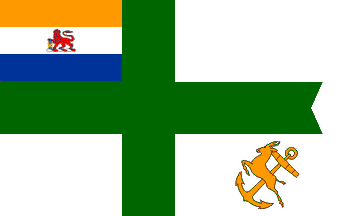 image
by Martin Grieve, 30 Jan 2006
image
by Martin Grieve, 30 Jan 2006
This flag was made in the proportions of 3:5 with a swallow tail in the fly; and
it had a white field with thereon a dark green cross one-fourth the depth of the
flag in width. The dark green cross was so placed on the flag that the cantons
next to the hoist were in proportion of 2:3. In the upper hoist canton was a
modified former national flag of South Africa, with the three small flags in the
centre of the white stripe being replaced by the crest of the coat of arms. In
the lower fly was the emblem of the South African Marine Corps, namely a
springbok leaping towards the hoist surmounting a plain inclined anchor, all in
orange.
This flag was worn day and night at the main mast starboard yard-arm whenever
the Naval and Marine Chief of Staff was on board a South African naval vessel.
When this flag was worn an admiral's flag or commodore's broad pennant of
masthead pennant was struck on that ship.
In 1955, it was found that the Corps of Marines could no longer fill a useful
role in the defence organization of South Africa and the Corps was disbanded and
consequently this flag ceased to be used.
Bruce Berry, 30 Jan 2006
Officer Commanding : Coastal Command (1952 - 1955)
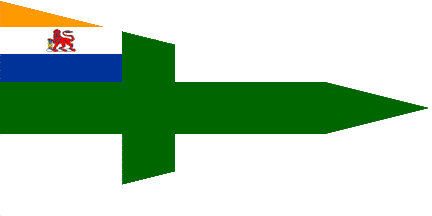 image by
Martin Grieve, 31 Jan 2006
image by
Martin Grieve, 31 Jan 2006
This pennant, in proportions 1:1, was the same design as the appointment flag of
the Naval and Marine Chief of Staff but without the emblem of the South Africa
Corps of Marines.
This pennant was flown to indicate the presence of the Officer Commanding :
Coastal Command, at any shore establishment within his command. This
appointment, and the flag, also ceased to exist following the disbanding of the
Corps of Marines in 1955.
Bruce Berry, 31 Jan 2006
Chief of Naval Staff (later Chief of the Navy) (1952 - 1972)
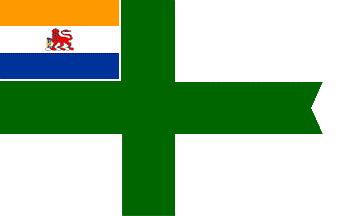 image
by Martin Grieve, 31 Jan 2006
image
by Martin Grieve, 31 Jan 2006
The flag was in the proportions of 3:5 and had a swallow-tail fly. It
was also of the same design as the flag for the Naval and Marine Chief
of Staff but without the emblem of the Corps of Marines in the fly; and
there was a white fimbriation between the modified South African
national flag in the canton and the arms of the dark green cross.
On 01 December 1965 the title Chief of Naval Staff was changed to Chief
of the Navy. The appointment flag remained unchanged until a new system
of rank flags was introduced on 28 August 1972.
Bruce Berry, 31 Jan 2006
Admiral (1972 - 1994)
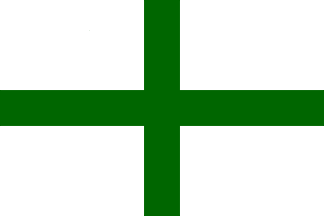 image by
Martin Grieve, 28 Apr 2004
image by
Martin Grieve, 28 Apr 2004
On 28 August 1972 a new series of rank flags was introduced, including the post
of Admiral. The Admiral's flag, in proportion 2:3, was a dark green cross on a
white field.
Bruce Berry, 02 Feb 2006
Admiral (1994 - )
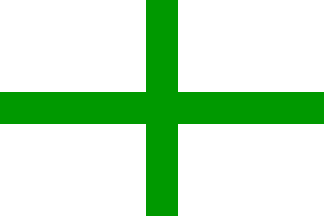 image
by Martin Grieve, 28 Apr 2004
image
by Martin Grieve, 28 Apr 2004
The design of the Admiral's flag remained unchanged following the adoption of
the new South African national flag in April 1994 except that the dark "tartan"
green was replaced by a lighter "national" flag green, the shade being the same
as the green stripe on the national flag and also used on the new naval ensign
adopted in November 1994.
Bruce Berry, 02 Feb 2006
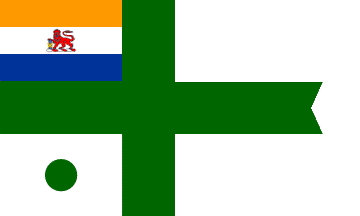 image
by Martin Grieve, 02 Feb 2006
image
by Martin Grieve, 02 Feb 2006The rank flags for Vice-Admirals were in
proportion 3:5 with a shallow swallow-tail in the fly, and were of the same
basic design as the appointment flag for the Naval Chief of Staff.
The flag of the Vice-Admiral had in the lower hoist canton a dark green ball,
the diameter of which was two-fifths of the vertical width of the canton.
Bruce Berry, 02 Feb 2006
Vice-Admiral (1972 - 1994)
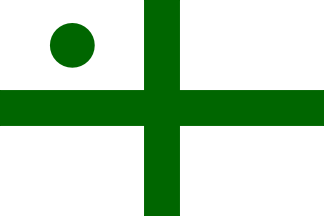 image
by Martin Grieve, 28 Apr 2004
image
by Martin Grieve, 28 Apr 2004
On 28 August 1972 a new series of rank flags was introduced. The
Vice-Admiral's flag was in proportion 3:5 with a dark green cross on a white
field. In the centre of the upper hoist canton was placed a dark green circular
ball.
Bruce Berry, 02 Feb 2006
Vice-Admiral (1994 - )
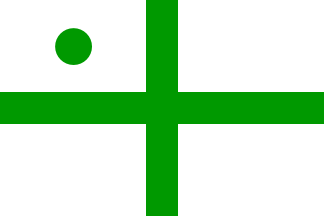 image
by Martin Grieve, 02 Feb 2006
image
by Martin Grieve, 02 Feb 2006
The design of the Vice-Admiral's flag remained unchanged following the adoption
of the new South African national flag in April 1994 except that the dark
"tartan" green was replaced by a lighter "national" flag green, the shade being
the same as the green stripe on the national flag and also used on the new naval
ensign adopted in November 1994.
Bruce Berry, 02 Feb 2006
Rear-Admiral (1952 - 1972)
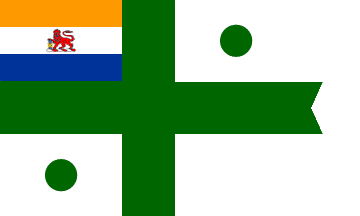 image
by Martin Grieve, 02 Feb 2006
image
by Martin Grieve, 02 Feb 2006
The rank flags for Rear-Admirals were in proportion 3:5 with a shallow
swallow-tail in the fly, and were of the same basic design as the appointment
flag for the Naval Chief of Staff.
The flag of the Rear-Admiral had in addition to the dark green ball in the
lower hoist canton, a
dark green ball in the upper fly canton. This second ball was of the
same diameter as the ball in the lower hoist canton; and it was placed
the same distance away from the vertical arm of the dark green cross as
the ball in the lower hoist canton was placed away from the hoist side
of the flag.
Bruce Berry, 02 Feb 2006
Rear Admiral (1972 - 1994)
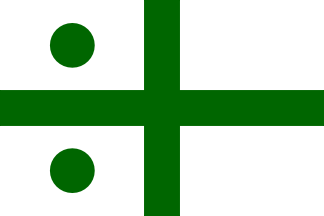 image
by Martin Grieve, 28 Apr 2004
image
by Martin Grieve, 28 Apr 2004
On 28 August 1972 a new series of rank flags was introduced. The
Rear-Admiral's flag was in proportion 3:5 with a dark green cross on a
white field. In the centre of both the upper and the lower hoists canton
was placed a dark green circular ball.
Bruce Berry, 02 Feb 2006
Rear Admiral (1994 - )
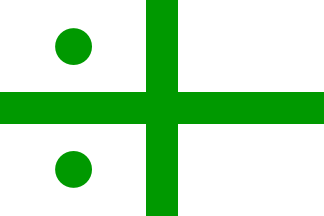 image
by Martin Grieve, 02 Feb 2006
image
by Martin Grieve, 02 Feb 2006
The design of the Rear-Admiral's flag remained unchanged following the
adoption of the new South African national flag in April 1994 except
that the dark "tartan" green was replaced by a lighter "national" flag
green, the shade being the same as the green stripe on the national flag
and also used on the new naval ensign adopted in November 1994.
Bruce Berry, 02 Feb 2006
Commander : Maritime Defence (1965 - 1968)
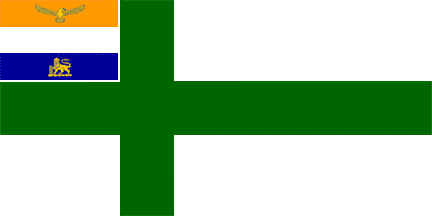 image
by Martin Grieve, 03 Feb 2006
image
by Martin Grieve, 03 Feb 2006
This post was established towards the end of 1965 with an appointment
flag having the same design as the naval ensign, modified by removing
the three small flags in the centre of the white stripe of the former
national flag. The orange stripe was charged with a gold representation
of the South African Air Force eagle and the blue stripe was charged
with a gold representation of the crest from the South African coat of
arms.
Bruce Berry, 02 Feb 2006
Commander : Maritime Defence (1968 - 1973)
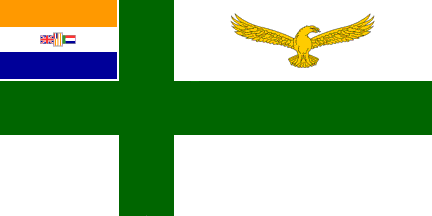 image
by Martin Grieve, 03 Feb 2006
image
by Martin Grieve, 03 Feb 2006
In March 1968, the design of this flag was changed so that it became the
same as the naval ensign, but with the addition in the upper fly canton
of a gold representation of the South African Air Force eagle. This flag was used until the
post was abolished on 30 September 1973.
Bruce Berry, 02 Feb 2006
An on-line Jane's Information Group publication to which I have access
through my work shows the rank structure of the South African Navy the
same as in Album 2000, with the grade between rear admiral and captain
entitled rear admiral (JG) [junior grade]. The insignia is a single
broad stripe, the same as for the UK Royal Navy rank of Commodore.
Joe McMillan, 04 Jan 2001
Commodore (1972 - 1994)
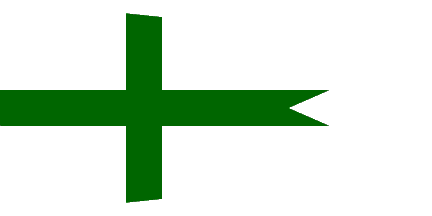 image
by Martin Grieve, 03 Feb 2006
image
by Martin Grieve, 03 Feb 2006
This flag follows the basic design as the broad pennant of a Commodore
in the British Royal Navy and is a white broad pennant containing a dark
green cross.
Bruce Berry, 03 Feb 2006
Commodore (1994 - )
The design of the Commodore's broad pennant flag remained unchanged
following the adoption of the new South African national flag in April
1994 except that the dark "tartan" green was replaced by a lighter
"national" flag green, the shade being the same as the green stripe on
the national flag and also used on the new naval ensign adopted in
November 1994.
Bruce Berry, 03 Feb 2006
 image by Martin Grieve,
07 Feb 2006
image by Martin Grieve,
07 Feb 2006
The masthead pennant used by the South African Navy, which tapers to a point at
the fly, is white with a dark green cross next to the hoist. The horizontal arm
of the cross lies along the centre line of the pennant and the vertical arm is
so placed that it is nearer to the hoist than the fly end of the cross.
Bruce Berry, 07 Feb 2006

image
by Martin Grieve,
07 Feb 2006
In common with the rank flags of the South African Navy, the shade of
green was changed in 1994 to the same as that used on the new national
flag. No other changes to the design were made.
Bruce Berry, 07 Feb 2006
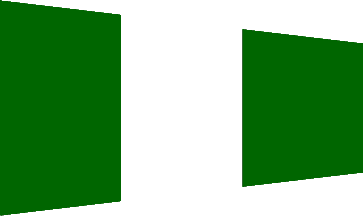 image
by Martin Grieve, 07 Feb 2006
image
by Martin Grieve, 07 Feb 2006
If this is the senior officer afloat pennant, a vertical green-white-green
triband, it is the "Starboard" signal pennant prescribed for use by NATO
navies to identify the senior officer present afloat (SOPA, in US terminology).
Some NATO navies use only this pennant for SOPA (including US, UK and Canada)
while others (such as France) use it when operating with Allied ships but
have a different SOPA pennant for use when operating unilaterally.
I suppose it has also been adopted by some other navies. The blue
triangle shown as the US SOPA pennant in A2K has not been in use since
about 1950.
Joe McMillan, 04 Jan 2001
When two or more South African naval vessels are together, this pennant
(also sometimes referred to as the Starboard Pennant) is worn to
indicate the vessel in which the senior officer in the group is
embarked. It is thus not a rank flag but a signal flag and is worn
normally only when the senior naval officer of the group is not entitled
to fly a Commodore's broad pennant or an Admiral's rank flag. This rule
doe not apply when South African naval vessels are in company with the
warships of other nations. In the latter case, the starboard pennant is
flown by the senior South African naval officer present, in addition to
any broad pennant or Admiral's rank flag which may be flying.
This pennant has a squared end and tapering horizontal sides and
consists of three equal vertical stripes of green, white and green. In
common with the other flags of the South African navy, the shade of
green was changed following the adoption of the new national flag in
1994.
Bruce Berry, 07 Feb 2006
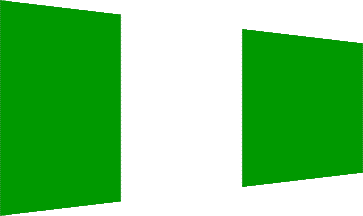 image by Martin Grieve, 07 Feb 2006
image by Martin Grieve, 07 Feb 2006
Several of the rank flags of the South African Navy are almost identical to
the rank flags of the Portuguese navy in a time when
Portugal and South Africa
shared long maritime borders before the independence of Angola and
Mozambique
and of later of Namibia. (Actually, back then South Africa *only* had maritime
borders with Portugal, although some of the fluvial borders could, perhaps, be
also navigable). The question is: how come? How did that happen? And don't
countries
usually adopt sets of relatively distinctive rank flags to avoid confusion?
Jorge Candeias, 02 Feb 2006
The command flags of the South African Navy (being more of less identical in
format) are obviously based on those of the Royal Navy, with a full admiral
flying
an undefaced cross and those of a junior grade of flag officer carrying
'balls of difference'. With the same being apparently true of the Portuguese
set.
It seems likely, therefore, that (the green being traditional in both countries)
the similarity comes from the fact that both sets of flags were based on the
same model.
Christopher Southworth, 02 Feb 2006
That they were based on the same model is evident, but the question lies in
the reasons why South Africa adopted a set so similar to that of a neighbour,
even more considering that green was *not* traditional in South Africa. Only
recently has the colour green made its way to the flag in a significant way;
before was just a small rectangle hidden among quite a few other small
rectangles, crosses and triangles.
Jorge Candeias, 02 Feb 2006
We have several South African members who are far better qualified than I to
answer this, but I would suggest (and subject to their correction) it rather
depends upon what period of time has to elapse before a colour becomes
'traditional'. Green was present in the flags of the 19th Century Boer
Republics, and was the natural choice when the time came to replace the red
cross of St George on the (second pattern of) SA naval ensign and therefore, on
the command flags.
Christopher Southworth, 02 Feb 2006
There is no connection whatsoever between the rank flags of the SA Navy and
the Portuguese Navy. Although the two navies came into contact from time to
time through port visits and joint small scale exercises, contact was otherwise
minimal - the cultural and language gap being too wide and South Africa being
very much part of the British sphere of influence. (There is also not a single
navigable river from south of the Congo river on the west coast right up to Suez
on the east coast, except a few by very small craft).
The green of the rank flags in the SA Navy was adopted as the result of the
adoption of the green cross on the naval ensign. From 1922 (when the South
African Navy, then known as the SA Naval Service, came into being), the
British White Ensign was flown by SA naval vessels
until 1946. In that year the White Ensign was replaced by a plain white ensign
with the national flag (the old orange, white and blue) in the canton. This
ensign was not popular in the fleet and also proved to be impractical in that it
was difficult to distinguish in low visibility. To solve this problem a green
cross was placed on the ensign. I have found some evidence that originally a
blue cross was proposed, but the then Minister of Defence (some say his wife!)
did not like the blue and proposed green instead, this being a more
traditional South African colour having been one of the colours of the old
Zuid-Afrikaansche Republiek Vierkleur
(four colour). Also, green was considered to be the colour of
freedom (from the British) among Afrikaners! Because the national flag was in
the proportions of 2:3 and the ensign followed the British practice of being
1:2, the vertical arm of the cross had to be offset slightly towards the hoist
and as a result the ensign was often described as having a green Scandinavian
cross. A further change in 1981 made the ensign also 2:3 and the cross became
square as it still is today after another change in 1994 when the new national
flag was adopted.
As for the pattern of the rank flags, the SA Navy today follows the same pattern
as the British Royal Navy today, as do most of the other Commonwealth Navies.
There is no problem with confusion. The ensign is the flag of national
identification and not the rank flags. There were no flag officers in the SA
Navy before 1952. The first set of naval rank flags were adopted in that year
and naturally used the same green for the crosses as in the ensign. As could be
seen from Bruce's second posting, the first pattern was different from that of
the British, but the pattern adopted in 1972, went back to the British pattern
except that the colour for the crosses and balls were green instead of red.
Andries Burgers, 02 Feb 2006